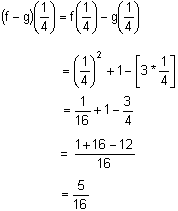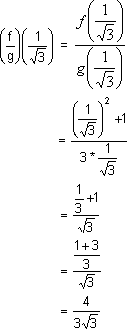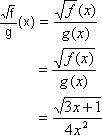A function is said to be Algebraic if it arises as a result of performing a finite number of fundamental algebraic operations (addition, subtraction, multiplication, division, root extraction, etc.) on polynomial functions.
Example
 is an algebraic function.
is an algebraic function.
If f and g are real functions with domain sets A, B, respectively, then both f and g are defined on A∩B.
We now define the functions
f+g, f-g, fg, f/g, f+k, kf, f n √f, | f | as follows.
- (f+g) (x) = f(x) + g(x) Domain = A∩ B
- (f-g) (x) = f(x) - g(x) Domain = A∩B
- (f*g) (x) = f(x) * g(x) Domain = A∩B
- f/g (x) = f(x)/g(x) Domain = { x | x ∈A∩B g(x) ≠0}
- (f+k) (x) = f(x) + k k is constant, Domain = A
- f n(x) = [f(x)]n is a positive integer, Domain = A

Domain is a subset of A or A∩{x | f(x) ≥0}- | f | (x) = |f(x)| Domain = A
The codomain of each of these functions is a real number set.
Example 1
f: R→R g:R→R defined by f(x) = x2-5, g(x) = 1-x
(f+g) (x) = f(x) + g(x)
= x2 - 5 + 1 - x
= x2 - x - 4
Example 2
f: R→R g:R→R defined by f(x) = 2x - 7, g(x) = 3 + 5x
(f-g) (x) = f(x) - g(x)
= 2x - 7 - (3+5x)
= 2x - 7 - 3 - 5x
= -10 - 3x
Example 3
f: R→R g: R→R defined by f(x) = 2x2 - 3, g(x) = 1 + x
(f *g) (x) = f(x) * g(x)
= (2x2 - 3) (1+ x)
= 2x2 - 3 + (2x2 - 3) x
= 2x2- 3 + 2x3- 3x
= 2x3 + 2x2 - 3x - 3
Example 4
f: R→R g: R→R defined by f(x) = 7x + 9, g(x) = x - 5 where x ≠ 5

Example 5
Let f: R→R and g: R→R defined by f(x) = x2 + 1 and g(x) = 3x. Find the value of
- (f+g) (-3)
- (f-g) (1/4)
- (f-g) (-√2)

Solutions:
- (f+g) (-3) = f(-3) + g(-3)
= (-3)2 + 1 + 3 * (-3)
= 9 + 1 - 9
= 1

- (f • g ) (- √2 ) = f (-√2) *g(-√2)
= [(- √2 )2 + 1] [3*-√2]
=[2+1] (-3√2)
=3-(-3√2)
=-9√2


Example 6
If f(x) = ax4 + bx2 + c is an even function, find c.
For f(x) to be an even function, f(-x) = f(x)
a(-x)4 + b(-x)2 + c= ax4 + bx2 + c
⇒ c can be any real number.
Example 7
If f(x) = px3+ qx + r is an odd function, find r.
For f(x) to be an odd function, f(-x) = -f(x)
p(-x)3 + q(-x) + r = - (px3 + qx + r)
⇒ r = -r
⇒ 2r = 0
⇒ r = 0
Try these questions
- If f(x) = x2 for x < 0
= x for 0 < x < 1
= 1/x for x ≥1
then find
1. (3f-6) (x)
2. f2(3)
3. f(-6) + f(1/2) - f(2)
Solution :
i. (3f - 6) (x) = (3f) (x) - 6
= 3 f(x) - 6
= 3x2 - 6 if x < 0
= 3x - 6 if 0 < x < 1
= 3/x - 6 if x ≥1
ii. f 2(3) = [f(3)]2 = (1/3)2 = 1/9 since 3 > 1
iii. f(-6) + f(1/2) - f(2)
f(-6) = (-6)2 since -6<0
= 36
f(1/2) = 1/2 since 0 < 1/2 < 1
f(2) = 1/2 since 2 > 1
then
f(-6) + f(1/2) - f(2) = 36 + 1/2 - 1/2
= 36
- f and g are real functions defined by f(x) = 3x + 1 and g(x) = 4x2. Find
1. -5f
2. f3
3. (3f-2g) (x)
4. (2fg) (x)
5. g3(x+1)
6. (√f /g) (x)
7. (f+g+2) (x)
Solution :
i. (-5f) (x) = -5 (f(x))
= -5(3x+1)
= -15x - 5
ii. f 3(x) = [f(x)]3
= (3x+1)3
iii. (3f-2g)(x) = (3f)(x) - (2g)(x)
= 3f(x) - 2g(x)
= 3(3x+1) - 2(4x2)
= 9x + 3 - 8x2
= 3 + 9x - 8x2
iv. (2fg)(x) = 2(fg)(x)
= 2f(x) * g(x)
= 2(3x + 1) (4x2)
= 8x2 (3x + 1)
= 24x3 + 8x2
v. g3 (x+1) = [g(x+1)]3
= [4(x+1)2]3
= 64(x+1)6
vi. 
assuming x≠0
vii. (f+g+2)(x) = f(x)+g(x)+2
= 3x + 1 + 4x2 + 2
= 4x2 + 3x + 3
- Let f: R→Z defined by f(x) = [x]
Find
1. f(-4)
2. f(3)
3. f(-7/4)
4. f(5/8)
Solution :
i. f(x) = [x] = n if n ≤ x < n + 1 where x is an integer.
f(-4) = -4 since -4 ≤ n < -3
ii. f(3) = [3] = 3 when 3 ≤ 3 n < 4
iii. f(-7/4) = [-1 3/4] since -7/4 = -1 3/4 , -2 ≤-1 3/4 < -1
= - 2
iv. f(5/8) = [5/8]
= 0 since 0 ≤ 5/8 < 1
Example 6